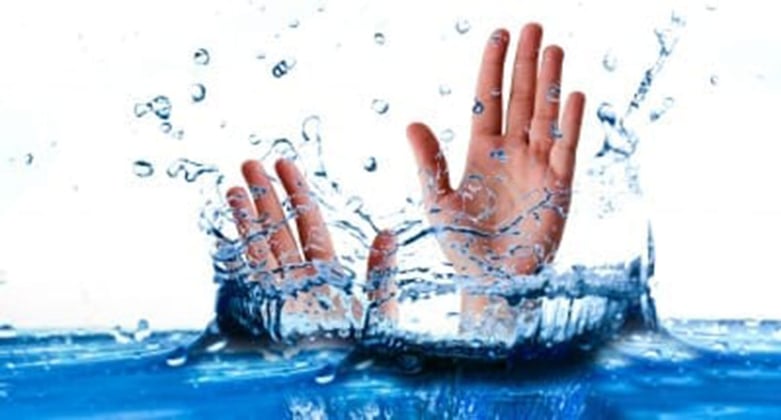Medical students should familiarize themselves with the basics of summertime first aid, particularly common seasonal concerns such as how to save someone from drowning; what to do if stung by a jellyfish; and how to treat cut feet from broken glass, debris or seashells on a beach and coral reefs while surfing or snorkeling. Caribbean medical school students, many of whom study year round on an island, need to know what to do in an emergency because many remote beaches do not have lifeguards or paramedics nearby.
The UMHS Pulse looks at the following three crucial areas of first aid to help you take action during peak beach season:
How to Save Someone from Drowning
Most first-aid websites agree that drowning victims aren’t always able to scream for help. As Reader’s Digest says, when someone is drowning, the mouth “sinks below and reappears above the surface of the water. There isn’t time for him/her to exhale, inhale, and call out.”
Wikihow.com offers ways to identify if someone is drowning and what steps to take:
- Identify a drowning victim. An active drowning victim is conscious and struggling. This type of victim displays the following characteristics:
- Unable to call for help
- Thrashing arms
- Vertical in the water
- Body is very low in the water, with the mouth just above the surface.
- Alert help, if possible. If you are the only person present, proceed to rescue the victim. If there are bystanders, yell for help so others are aware of the situation or can also help with the rescue.
- Get a flotation device, if available. This will allow the victim something to hold onto once he/she is reached. The most common type of flotation device is called a rescue tube, often seen at public pools and beaches, and are used by lifeguards.
- Begin the rescue. Enter the water and approach the victim. The safest way to avoid harm to oneself is to approach the victim from behind. An active drowning victim’s only concern is getting air. In fear, he/she may grab onto you and pull you under, resulting in two victims.
- Place your arms under the victim’s. Once you get behind the victim, place your arms under each of the victim’s armpits. Bend your arms back so you are pointing at yourself and hold tight. If you are using a flotation device, keep it between you and the victim, across your chest.
- Reassure the victim. As you pull the victim to safety, calm the victim down by saying “Are you okay?” or “You’re going to be okay.” Swim calmly and slowly while pulling the victim, unless they need immediate help.
Remember that rescue is only part of the job. What do you do once you get the victim ashore? While waiting for paramedics to arrive, if the victim is unconscious or has swallowed water, do the following, says FamilyEducation.com:
- Turn the drowning person's head to the side, allowing any water to drain from his or her mouth and nose. Turn the head back to the center.
- Begin mouth-to-mouth resuscitation on land, if possible.
- Strongly breathe four times into the mouth of the injured person as you pinch his/her nose. This helps air get past any water that is clogging the breathing passageways and the lungs.
- After four strong breaths, put your ear near the mouth and watch the chest for any breathing movement.
- Check the pulse for signs of life.
- Repeat the cycle.
Treating Jellyfish Stings
 Whether you’re spending the summer on Cape Cod, Hilton Head Island, South Beach or in the Caribbean, jellyfish stings are cause for concern. To be safe, you should always have someone get a doctor if you’ve been stung by any type of jellyfish, but people stung in tropical waters might encounter box jellyfish, a sea creature whose venom can be deadly.
Whether you’re spending the summer on Cape Cod, Hilton Head Island, South Beach or in the Caribbean, jellyfish stings are cause for concern. To be safe, you should always have someone get a doctor if you’ve been stung by any type of jellyfish, but people stung in tropical waters might encounter box jellyfish, a sea creature whose venom can be deadly.
(Photo, inset right) The infamous folk remedy for jellyfish stings doesn't work. Photo: FreeDigitalPhotos.net
The website Buzzle warns, “Coming to the venom, it contains several toxins that attack the heart, nervous system and skin cells. It is so powerful and painful that the victim goes into shock.”
In most North American waters, however, jellyfish are usually not deadly, but their stings are still quite painful. Everyone has heard the folk remedy of urinating on a jellyfish sting to ease the pain, but does doing so actually work? ScientificAmerican.com says no, and this practice could make matters worse. The website explains, “Urine can actually aggravate the jellyfish's stingers into releasing more venom. This cure is, indeed, fiction.”
Most first-aid websites say rinsing the sting with seawater will ease the pain and help remove the nematocysts (stingers) that inject venom into the skin. Fresh water won’t do the job well because rinsing with it could cause more stingers to fire venom.
Dr. Paul Auerbach (considered an expert on jellyfish stings), of Stanford University Hospital, tells ABCNews.com that vinegar is the best remedy for stings from North American jellyfish.
Dr. Suzanne Shepherd, a travel medicine specialist and emergency physician at the University of Pennsylvania, has been stung by jellyfish and tells ABCNews.com that she always takes vinegar with her when she goes for a swim in the ocean.
Dr. Auerbach and Dr. Shepherd give the following steps for correct jellyfish sting first-aid:
- If stung by a jellyfish, get out of the water immediately and to a safe area.
- If a tentacle is wrapped around an arm or leg, remove it using another object, such as a stick.
- Inactivate the stingers, or nematocysts, that attach to the skin after brushing up against jellyfish tentacles. The best thing to use is acetic acid, or regular household white vinegar.
- Do not rub the sting. Doing so may cause more stingers to fire venom.
- Apply vinegar by soaking a paper towel or thin cloth in vinegar and gently placing it to over the sting for 30 minutes. Or pour the vinegar directly over the area. Rubbing alcohol can also inactivate nematocysts, but should never be rubbed directly into the sting.
- Bring a 50-50 mixture of vinegar and rubbing alcohol when you go to the beach.
- Unseasoned meat tenderizer, zinc oxide, baking soda, household ammonia and lemon or lime juice can also ease the pain of jellyfish stings. To avoid a rash, don’t leave meat tenderizer on too long.
- Baking soda is particularly effective on stings caused by nettle jellies, commonly found along the U.S. East Coast.
- Once the nematocysts have been deactivated, remove them from the skin by gently applying shaving cream to the area and scraping them off with a safety razor. If no shaving supplies are available, use sand and a shell instead.
- Use hydrocortisone cream to decrease skin irritation. If it's not strong enough, see your physician for a prescription steroid cream.
- The rash from the sting can last anywhere from 24 to 48 hours, although this is highly variable. If pain or rash persists, see a doctor.
- In tropical areas, stings by the dangerous box jellyfish are best treated by rinsing the affected area with vinegar. If you are swimming in tropical waters and think you may have been stung by a box jellyfish, yell for help and get immediate attention from a doctor.
Treating Cuts from Glass, Seashells, Debris & Reefs
 Anyone who has ever walked on a beach barefoot or even in flip-flop sandals has probably had their feet cut by broken glass, seashells or debris in rough surf that washes up on you. Jagged driftwood in the surf at high tide can leave a painful cut or abrasions (scrapes) on the feet, ankles and lower legs, even if one is wearing sandals. Surfing or snorkeling can also result in cuts and abrasions from debris or coral reefs.
Anyone who has ever walked on a beach barefoot or even in flip-flop sandals has probably had their feet cut by broken glass, seashells or debris in rough surf that washes up on you. Jagged driftwood in the surf at high tide can leave a painful cut or abrasions (scrapes) on the feet, ankles and lower legs, even if one is wearing sandals. Surfing or snorkeling can also result in cuts and abrasions from debris or coral reefs.
(Photo, inset right) Beware of your bare feet on the beach. Photo: Keerati/FreeDigitalPhotos.net
OrangeCounty.com gives the following first-aid steps for beach, reef and surfing-related cuts and abrasions:
Step 1: Stop the bleeding and clean the wound of all sand, coral, and foreign material (a new toothbrush works well; do not use an old one as your mouth has a ton of bacteria in it). Use soap, mild saline water and sterilized cotton. If it is a deep cut, use Betadine or hydrogen peroxide or any would-cleansing agent to wash the surface. (Only use lime juice if nothing else is around; it is not clean or sterile at all.)
Step 2: Apply antibiotic cream on the surface of the wound as a final dressing.
Step 3: Cover the cut with a bandage or gauze to hold it in place.
Step 4: Repeat through the day as necessary.
Recommended treatments include:
- Hydrogen peroxide: This is a mild antiseptic used on the skin to prevent infection of minor cuts, scrapes, and burns. This product works by releasing oxygen when it is applied to the affected area. The release of oxygen causes foaming, which helps to remove dead skin, disinfect and clean the area.
- Antibiotic ointment/Neosporin: This is the go-to for cuts to help them heal quickly and fight bacteria.
- Betadine: For cuts and scrapes from coral reefs in tropical waters, use Betadine to kill the harmful bacteria. Betadine is used hospitals worldwide as an important first line of defense against topical infections. Betadine helps to reduce bacteria that potentially can cause skin infection.
Wired How-To Wiki’s website says cuts and water-related wounds should be immediately cleaned and dressed in bandages. “If the cut is deep, try to stem excessive bleeding by pressing a clean shirt or towel against the wound and apply pressure until the bleeding stops,” the site says. “Removing the makeshift bandage may reopen the wound. Keep the shirt or towel held against the wound until you are around more suitable dressings or help arrives.”
The American College of Foot and Ankle Surgeons’ official website says to avoid going into the water after a cut or abrasion on the beach because bacteria in oceans and lakes can cause infection. Serious puncture wounds should be treated by a doctor within 24 hours to avoid any complications.
(Top photo) Drowning victims can’t always scream for help. Photo: FreeDigitalPhotos.net
About UMHS:
Built in the tradition of the best US universities, the University of Medicine and Health Sciencesfocuses on individual student attention, maintaining small class sizes and recruiting high-quality faculty. We call this unique approach, “personalized medical education,” and it’s what has led to our unprecedented 96% student retention rate, and outstanding residency placements across the US and Canada. UMHS is challenging everything you thought you knew about Caribbean medical schools.

Scott is Director of Digital Content & Alumni Communications Liaison at UMHS and editor of the UMHS Endeavour blog. When he's not writing about UMHS students, faculty, events, public health, alumni and UMHS research, he writes and edits Broadway theater reviews for a website he publishes in New York City, StageZine.com.
















